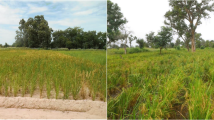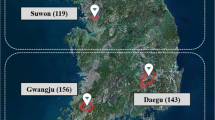Abstract
Climate change will have significant impacts on the rain-fed rice production ecosystem, and particularly on the ecosystem’s hydrology and water resources. Under rain-fed lowland conditions, substantial variations among fields in grain yield are commonly observed, but a method that can account for field-scale yield variability to produce regional-scale yield estimates is lacking, thereby limiting our ability to predict future rice production under changing climate and variable water resources. In this study, we developed a model for estimating regional yields of rain-fed lowland rice in Northeast Thailand, by combining a simple crop model with a crop calendar model. The crop model incorporates the effects of two important resources (water and nitrogen) on crop growth. The biomass accumulation is driven by water use, whereas the nitrogen supply determines canopy development and thereby constrains crop water use. Accounting for the wide range of planting dates and the strong photoperiod-sensitive characteristics of rice varieties through the calendar model is an essential component in determining regional yield estimates. The present model does not account for the effects of mid-season drought or flooding, but was nonetheless able to explain the spatial and temporal yield variations at the province level for the past 25 years. Thus, it can be used as a prototype for simulating regional yields of rain-fed lowland rice.




Similar content being viewed by others
References
Adachi F, Kobata T, Arimoto M, Imaki T (1996) Comparison of water use efficiency of paddy rice (Otyza sativa L.) among locations and interannual variation in humid arias. II. Comparison among three locations and two cultivars in Shimane Prefecture. Jpn J Crop Sci 65:173–180 (in Japanese with English abstract)
Adachi F, Kobata T, Imaki T (1999) Leaf nitrogen contents as a dominant factor determining water-use efficiency of paddy rice. In: Horie T et al (eds) Proc Int Symp “World Food Security”, Kyoto, pp 312–313
Allen RG, Pereira LS, Raes D, Smith M. (1998) Crop evapotranspiration—guidelines for computing crop water requirements. FAO Irrigation and Drainage Paper 56. FAO, Rome, pp. 15–86
Black JN (1956) The distribution of solar radiation over the Earth’s surface. Arch Meteorol Geophys Bioklimatol B 7(2):165–189
Fukai S, Rajatasereekul S, Boonjung H, Skulkhu E (1995) Simulation modeling to quantify the effect of drought for rainfed lowland in Northeast Thailand. In: Fragile lives in fragile ecosystems. Proceedings of the International Rice Research Conference, 13–17 February, PO Box 933, Manila, Philippines, pp 657–674
Fukui H, Chumphon N, Hoshikawa K (2000) Evolution of rain-fed rice cultivation in Northeast Thailand: increased production with decreased stability. Global Environ Res 2:145–154
Gregory PJ (2004) Agronomic approaches to increasing water use efficiency. In: Bacon MA (eds) Water use efficiency in plant biology. Blackwell Publishing Ltd, Oxford, pp 142–170
Hasegawa T, Horie T (1997) Modelling the effect of nitrogen on rice growth and development. In: Kropff MJ et al (eds) Application of systems approaches at the field level, Kluwer Academic Publishers, UK, pp 243–257
Hayano M, Horikawa N, Kuwagata T, Furuya J, Ishigooka Y, Hasegawa T, Taniguchi T, Toritani H, Tada M, Masumoto T (2008) Features of the AFFRC model for evaluating the relationship between water cycle and rice production. Paddy Water Environ. doi:10.1007/s10333-008-0106-1
Hayashi S, Kamoshita A, Yamagishi J, Kotchasatit A, Jongdee B (2007) Genotypic differences in grain yield of transplanted and direct-seeded rainfed lowland rice (Oryza sativa L.) in northeastern Thailand. Field Crop Res 102:9–21
Homma K, Horie T, Ohnishi M, Shiraiwa T, Supapoj N, Matsumoto N, Kabaki N (2001) Quantifying the toposequential distribution of environmental resources and its relationship with rice productivity. In: Fukai S, Basnayake J (eds) Increased lowland rice production in the Mekong Region. Proceedings of an International Workshop, Vientiane, Laos, pp 281–291
Homma K, Horie T, Shiraiwa T, Supapoj N, Matsumoto N, Kabaki N (2003) Toposequential variation in soil fertility and rice productivity of rainfed lowland paddy fields in mini-watershed (Nong) in Northeast Thailand. Plant Prod Sci 6(2):147–153
Homma K, Horie T, Shiraiwa T, Sripodok S, Supapoj N (2004) Delay of heading date as an index of water stress in rainfed rice in mini-watersheds in Northeast Thailand. Field Crop Res 88(1):11–19
Ishigooka Y, Kuwagata T, Goto S, Toritani H, Ohno H, Urano S (2008) Modeling of continental-scale crop water requirement and available water resources. Paddy Water Environ. doi:10.1007/s10333-007-0098-2
Jongdee S, Mitchell JH, Fukai S (1997) Modelling approach for estimation of rice yield reduction dut to drought in Thailand. In: Fukai et al (eds) Breeding strategies for rainfed lowland rice in drought-prone environments. Proceedings of an International Workshop held at Ubon Ratchathani, Thailand, 5–8 November 1996, ACIAR Proceedings No. 77, pp 13–22
Kono Y, Tomita S, Nagata Y, Iwama K, Nawata E, Junthotai K, Katawatin R, Kyuma K, Miyagawa S, Niren T, Noichana C, Sakuratani T, Sributta A, Watanabe K (2001) A GIS-based crop-modelling approach to evaluating the productivity of rainfed lowland paddy in north-east Thailand. In: Fukai S, Basnayake J (eds) Increased lowland rice production in the Mekong Region. Proceedings of an International workshop, Vientiane, Laos, pp 301–318
Ministry of Agriculture and Cooperatives (1976–1999) Agricultural statistics of Thailand crop year, Center for Agricultural Information, Office of Agricultural Economics, Ministry of Agriculture and Co-operative, Bangkok, Thailand
Mitchell TD, Carter TR, Jones PD, Hulme M, and New M (2004) A comprehensive set of high-resolution grids of monthly climate for Europe and the globe: the observed record (1901–2000) and 16 scenarios (2001–2100). Tyndall Center Working Paper 55
Miyagawa S, Kuroda T (1988) Variability of yield and yield components of rice in rain-fed paddy fields of Northeast Thailand. Jpn J Crop Sci 57(3):527–534
Miyagawa S, Kono Y, Nagata Y, Nawata E (1999) Technical changes in rainfed rice cultivation in Northeast Thailand. In: Horie T et al (eds) Proc Int Symp “World Food Security”, Kyoto, pp 169–172
Naklang K, Harnpichitvitaya D, Amarante ST, Wade LJ, Haefele SM (2006) Internal efficiency, nutrient uptake, and the relation to field water resources in rainfed lowland rice of northeast Thailand. Plant Soil 286(1–2):193–208
Ohnishi M, Horie T, Homma K, Kondo S, Takano H, Inamura T, Thongthai C, Supapoj N (1999a) Modeling and evaluation of productivity of rainfed rice in Northeast Thailand. In Horie T et al (eds) Proc Int Symp “World Food Security”, Kyoto, pp 173–176
Ohnishi M, Horie T, Homma K, Supapoj N, Takano H, Yamamoto S (1999b) Nitrogen management and cultivar effects on rice yield and nitrogen use efficiency in Northeast Thailand. Field Crop Res 64(1):109–120
Oki T and Kanae S (2006) Global hydrologic cycle and world water resources. Science 313(5790):1068–1072. doi:10.1126/science.1128845
Parry M, Rosenzweig C, Livermore M (2005) Climate change, global food supply and risk of hunger. Philos Trans R Soc Lond B Biol Sci 360(1463):2125–2138
Sawano S, Hasegawa T, Goto S, Konghakote P, Polthanee A, Ishigooka Y, Kuwagata T, and Toritani H (2008) Modeling the dependence of the crop calendar for rain-fed rice on precipitation in Northeast Thailand. Paddy Water Environ. doi:10.1007/s10333-007-0102-x
Shiraiwa T, Nakagawa H, Horie T, Matsui T, Homma K (2002) Variation in rice production in Northeast Thailand and the impact of precipitation Chikyukankyo 6:207–215 (in Japanese)
Suzuki K, Goto A, Mizutani M, Sriboonlue V (2003) Simulation model of rainfed rice production on sloping land in northeast Thailand. Paddy Water Environ 1(2):91–97
Takami S (1994) Simulation of plant growth and development. In: Japanese Society of Agricultural Meteorology (ed) New agricultural meteorology and environmental sciences, Yokendo Ltd, Tokyo, pp 174–189 (in Japanese)
Acknowledgments
This study was financially supported by the research project of Ministry of Agriculture Forestry and Fisheries “Assessment of the impact of global-scale change in water cycles on food production and alternative policy scenarios.”
Author information
Authors and Affiliations
Corresponding author
Rights and permissions
About this article
Cite this article
Hasegawa, T., Sawano, S., Goto, S. et al. A model driven by crop water use and nitrogen supply for simulating changes in the regional yield of rain-fed lowland rice in Northeast Thailand. Paddy Water Environ 6, 73–82 (2008). https://doi.org/10.1007/s10333-007-0099-1
Received:
Accepted:
Published:
Issue Date:
DOI: https://doi.org/10.1007/s10333-007-0099-1




